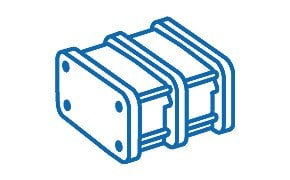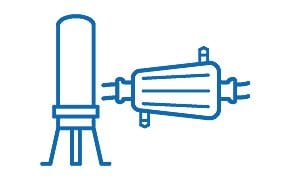Plasmid DNA Purification Process
Plasmid DNA (pDNA) is an essential component of, and key technology for production of viral vector, mRNA, and vaccine therapies. The far-reaching potential of novel therapeutic modalities and vaccines that rely on pDNA is driving increased demand and the need for improved production strategies.
Overview of the Plasmid DNA Manufacturing Process
The starting material for pDNA purification after lysis is complex with pDNA representing only 3% of the content while the remaining 97% represents impurities. pDNA production presents several challenges. Our plasmid DNA downstream purification website provides guidance to help you select the right technologies to minimize pDNA challenges and streamline your plasmid DNA production.
General Process for pDNA Manufacturing
The manufacturing schemes for pDNA were first developed in the mid-1980s and have since relied on well-established production processes, typically fermentation using a microbial source, usually E. coli.
Downstream process development for pDNA manufacturing includes the following steps:


Chromatography (1-2 steps)
Chromatography: Anion exchange chromatography (AEX) and hydrophobic interaction chromatography (HIC) are the most used chromatography technologies for plasmid purification. Size exclusion chromatography can be used as the last chromatography step.

Ultrafiltration/Diafiltration (UF/DF)
Ultrafiltration/diafiltration: Tangential flow filtration separates, concentrates, washes, and transfers the plasmid DNA into a compatible buffer for subsequent steps.

Final Sterile Filtration
Final sterile filtration: Final sterile filtration removes microbial contaminants that may have been introduced during processing.
The final bulk pDNA must meet quality specifications set by regulatory agencies.
Challenges in Plasmid DNA Production
With the growing demand for pDNA in the production of viral vectors, mRNA, and vaccine therapies, upstream productivity must be increased to achieve yield and efficiency goals, ensure robust impurity removal and maximize downstream recovery. The starting material for pDNA purification is complex with pDNArepresenting only 3% of the content while the remaining 97% represents impurities. Thus, pDNA production presents several challenges.
Plasmids are Large and Negatively Charged
Production suffers from low productivity of microbial fermentation and the purification process is complicated by the fact that plasmids are generally large and highly negative charged. The bacterial lysate contains contaminants with similar properties to pDNA. Most of the impurities are negatively charged (RNA, genomic DNA, endotoxins), similar in size (open circular pDNA, genomic DNA, high molecular weight RNA), and hydrophobic (endotoxins). These similarities can lead to low resolution separation.
Bacterial Lysates are Highly Viscous
Bacterial lysate can be highly viscous. A low flow rate is needed for chromatography, and it can be difficult to achieve the desired concentrations at the final tangential flow filtration (TFF) step.
Plasmids are Sensitive to Mechanical Damage
pDNA is sensitive to mechanical damage, which can lead to changes in its topological form. Plasmid isoforms include supercoiled (fully intact and wound around itself), open circular (one strand is broken and the molecule relaxes) and linear (both strands are broken with free ends). Supercoiled plasmids are recognized as the most therapeutically relevant, and regulatory agencies set expectations for the purity of the supercoiled form in final drug substance for DNA vaccines.
Designing a Plasmid DNA Downstream Purification Process
Our plasmid DNA downstream purification eBook provides you with guidance to select the right products and chemicals to optimize and streamline your plasmid DNA downstream process development. We explore Cell Harvest, Lysis, Neutralization and Clarification, Chromatographic Purification, Tangential Flow Filtration (TFF), and Sterile Filtration unit operations.
This guide also includes data from our collaboration with a biotechnology company focused on the design and development of RNA-based therapeutics and products which might help you navigate the product selection process.
Related Products
Learn more about the Emprove® Program, designed to help you maintain compliance with current Good Manufacturing Practices.
To continue reading please sign in or create an account.
Don't Have An Account?